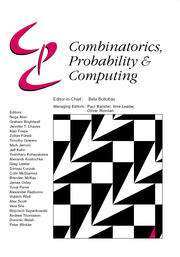Article contents
The Dual BKR Inequality and Rudich's Conjecture
Published online by Cambridge University Press: 02 December 2010
Abstract
Let  be a set of terms over an arbitrary (but finite) number of Boolean variables. Let U(
be a set of terms over an arbitrary (but finite) number of Boolean variables. Let U( ) be the set of truth assignments that satisfy exactly one term in
) be the set of truth assignments that satisfy exactly one term in  . Motivated by questions in computational complexity, Rudich conjectured that there exist ∊, δ > 0 such that, if
. Motivated by questions in computational complexity, Rudich conjectured that there exist ∊, δ > 0 such that, if  is any set of terms for which U(
is any set of terms for which U( ) contains at least a (1−∊)-fraction of all truth assignments, then there exists a term t ∈
) contains at least a (1−∊)-fraction of all truth assignments, then there exists a term t ∈  such that at least a δ-fraction of assignments satisfy some term of
such that at least a δ-fraction of assignments satisfy some term of  sharing a variable with t [8].
sharing a variable with t [8].
We prove a stronger version: for any independent assignment of the variables (not necessarily the uniform one), if the measure of U( ) is at least 1 − ∊, there exists a t ∈
) is at least 1 − ∊, there exists a t ∈  such that the measure of the set of assignments satisfying either t or some term incompatible with t (i.e., having no satisfying assignments in common with t) is at least
such that the measure of the set of assignments satisfying either t or some term incompatible with t (i.e., having no satisfying assignments in common with t) is at least  . (A key part of the proof is a correlation-like inequality on events in a finite product probability space that is in some sense dual to Reimer's inequality [11], a.k.a. the BKR inequality [5], or the van den Berg–Kesten conjecture [3].)
. (A key part of the proof is a correlation-like inequality on events in a finite product probability space that is in some sense dual to Reimer's inequality [11], a.k.a. the BKR inequality [5], or the van den Berg–Kesten conjecture [3].)
Information
- Type
- Paper
- Information
- Copyright
- Copyright © Cambridge University Press 2010
References
- 11
- Cited by

